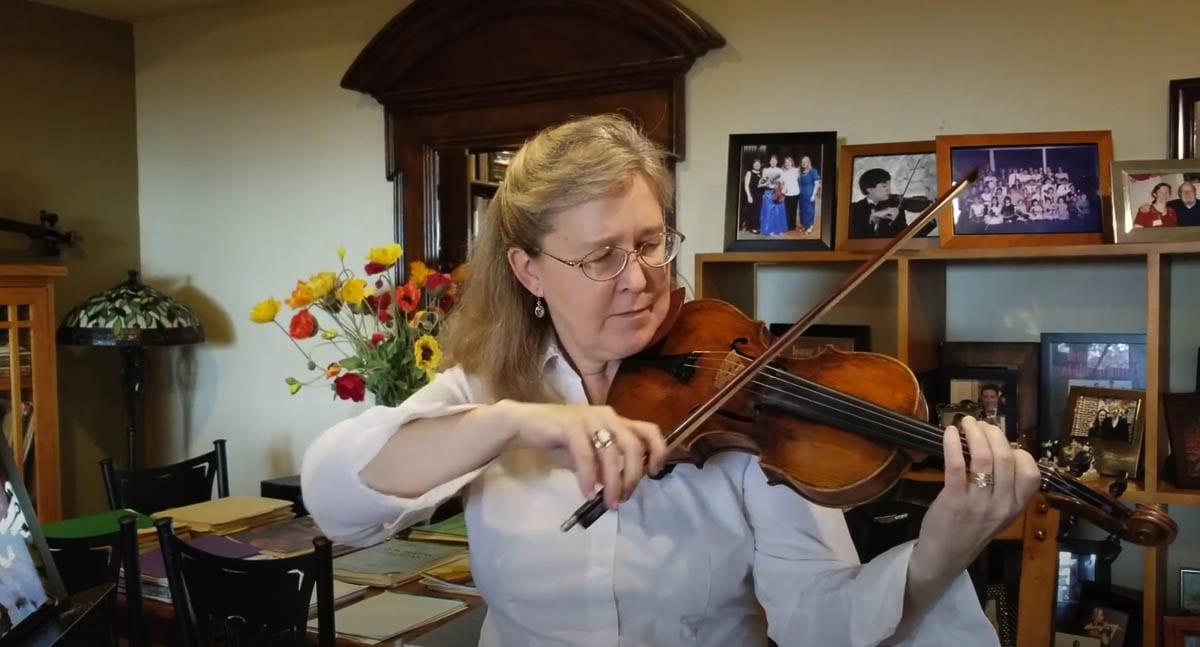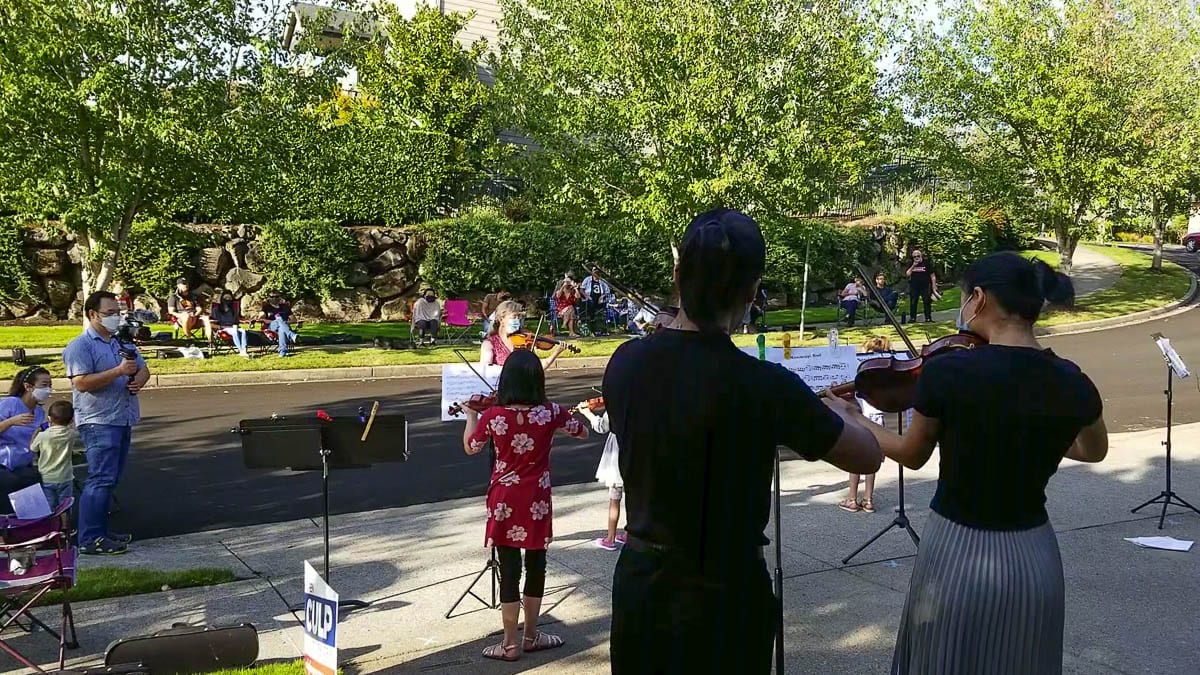Oregon Symphony member loves performing the violin and instructing as well
When she’s not teaching students, and when she’s not practicing or playing with the Oregon Symphony, Clarisse Atcherson enjoys quiet. “I always have music playing in my head,” says the violin player and teacher. She’s the only member of the Oregon Symphony who doesn’t live in Oregon. Camas is her home.

Her music is her passion. Clarisse teaches violin to about 30 young people who share her love of the instrument. Her youngest student is just over four years old; and her oldest at the moment is a junior in high school. They come from all over the Portland area.
Atcherson grew up in a musical family. Her father was a professor of Music Theory at the University of Iowa. Her mother was also a music teacher, and her sister plays the violin. She began playing the violin at age 4 and loves performing. She kept the same violin teacher all the way through high school.
“I realize now as a professional, that’s very rare,” Atcherson said. “Because most students, they start with a teacher who’s good at beginners. Then they move later to a teacher who’s good at the more intermediate level, and then later, they move to a teacher who can do the more advanced level.
“I was grateful, I realized later how nice it was to have just one teacher who could cover all the levels. And that’s the kind of teacher I decided I wanted to be.” she said.
Early on, she practiced hard and was very committed to playing the violin during the school year. But she enjoyed attending Girl Scout summer camps in her youth, where there was no time to practice her violin. That changed when she was 10. Her teacher stopped teaching summers at the Interlochen Center for Performing Arts in Michigan and remained in Iowa. That allowed Clarisse to receive year round instruction.
At age 16, Clarisse attended an 8-week music summer camp, the Interlochen Center for Performing Arts. “Interlochen is a very high quality, nationally recognized music school — people came from other countries to study there.” she said. The competition energized her to practice even harder. She loved performing with others who excelled.
Every week there were competitions. Fellow students listened with their backs to the two competitors. The same music was played by both competitors, and their fellow students voted on who played the music better.
“We were doing Tchaikovsky Fourth Symphony, I never played notes that high over and over,” she said. “I mean, it’s a really big piece. So I practiced a whole lot. But one day I moved up seven chairs; and that day the camp was talking about ‘Did you hear about that girl from Iowa? She moved up seven chairs in one day?”
She returned to Interlochen the next summer and after that experience, she decided she wanted to play the violin professionally.
She attended the Eastman School of Music in Rochester, NY. It had small class sizes — she was one of 18 incoming freshmen violinist students. Most of her classes had perhaps a dozen students.
“They had a high ratio of practice rooms per student, which is a concern at a music school,” Clarisse said. “You have to have somewhere where you can practice. You need to be able to practice, the standard is five hours a day.” At larger music schools, students often have problems finding practice rooms.
“My teacher was Charlie Castleman, who had studied with Galamian,” she said. “He had won competitions. In his younger years, he won the Queen Elizabeth of Belgium, which is an extremely important violin competition. Probably the most other than the Tchaikovsky competition.
“So, he was an international competition winner. He was a child prodigy. He had studied with Galamian, who was the best pedagogue (strict teacher) at that time. He probably was 40 when he started teaching at the Eastman School of Music.”
Clarisse mentioned that one advantage of Rochester was the weather — it kept the students indoors, which was conducive for more practicing. She recalls in May, students would actually play soccer outside on the residence hall lawn. That was something that was unheard of any other time of the year. Partly because of the weather and also because they were working so hard.
She later earned her Masters degree from Southern Illinois University at Edwardsville. While there, she studied pedagogy with John Kendall. “People came from all over the world to study with him,” she said.
Kendall taught the Suzuki methodology of instruction. Clarisse was certified through the Suzuki Association of the Americas to teach all 10 Suzuki books.
“I realize now how rare that is because most Suzuki instructors have to piecemeal one book at a time starting at an institute,” she said. “The fact that I was able to learn how to teach all 10 books from a master over the course of two years, was a really big deal.”
The Suzuki method of instruction includes parental responsibility, offering loving encouragement and constant repetition. Just like when a child learns to talk, parents are involved in the musical learning of their child. They often attend lessons with the child and serve as “home teachers” during the week. Parents work with the teacher to create an enjoyable learning environment.
“For most children practicing a lot is not high on their agenda,” she said. “That’s the part of the success of the Suzuki method, which is what my teacher used and which is what I use with younger students. The self discipline of the parent helps the child learn self discipline, because children don’t automatically just pick up the violin and play for an hour.”
Clarisse auditioned for the Oregon Symphony roughly a week before she graduated with her master’s degree. “I won the audition, so my future was decided. I was going to come here,” she said.
“Auditioning is a different skill,’’ she said. “You have to prepare a dozen or so orchestral works, plus one or two concertos. There is also a sight reading part of the audition in the final round.” It takes five hours a day for at least a few months to prepare for an audition, because there’s so much repertoire.
Clarisse joined the Oregon Symphony in 1985. She has served on the faculty at the Community Music Center in Portland for 30 years and also serves on the board of the Oregon Chapter of the American String Teachers Association.
Her sister and brother-in-law live in Eugene, so that was one reason she was attracted to the Oregon Symphony. She met her husband, David a year after moving here. They were married two years later.
She was asked if there is regular competition to move up in positions, within the symphony.
“People don’t realize this, but once you’re in, you’re in,” she said. “You don’t compete for higher chairs, unless you want to go to the national audition for the Oregon Symphony and compete against everybody else who comes from across the country.” Changing positions is rare.
“My fixed chair was halfway up the first violin section,” she said.” I was perfectly happy with it; it was a good chair.”
Clarisse mentioned that ticket sales account for less than 50 percent of the total total cost of the organization. They rely heavily on donors.
The city of Portland owns Schnitzer Hall, which the symphony pays hundreds of thousands of dollars to rent every year. A big part of the symphony budget is renting that hall. They have a dream of fundraising enough money to build a new hall for the Oregon Symphony, so that they would have a residence hall.
The Oregon Symphony season usually starts in late August, and goes until early to mid June. “You can think of it as being like a public school teacher,” she said. “We play the same months that public school teachers teach.”
The symphony’s normal work week is Thursday through Tuesday. Wednesday is their day off. Symphony players don’t have weekends. “That’s the nature of the job,” she said. “We play when people have time to come to a concert.”
The concert schedule is busy. “Once or twice a month we play in Salem on Friday night. And then in Portland, we play Saturday, Sunday, Monday.”
In a classical series, they play four nights in a row Friday, Saturday, Sunday afternoon, Monday evening. In a popular special, they might only play once or twice, or maybe three times if it’s a really popular pops. For Christmas, they usually play four times. “The idea is, the more times we play a concert, if it’s one that sells well, the more ticket revenue comes in,” she said.
As if that schedule wasn’t enough, Clarisse teaches young people. “I always wanted to teach,” she said. “The schedule was congenial enough that I could teach in the after-school hours. Some days I would have rehearsal in the morning, come back and teach all afternoon, and go play a concert at night.”
She began teaching in January 1986. She gets students by word of mouth. However the Portland Youth Philharmonic and the Metropolitan New Symphony, keep a list of teachers, including Clarisse. She presently has about 30 students.
Performing is part of her instruction. Most teachers have recitals once or twice a year, but Clarisse tries to have one every month. “I think it’s important for the kids to get to perform when they’re ready and not have to wait months and months,” she said. “It is part of the performing and practicing that they have to have a goal.”
“You can see in the music room, it’s normally set up with all the chairs on this side,” she said. “The student plays over there by the piano, and everybody sits here, like an audience. That’s why we bought this house, by the way, because it had enough space for home recitals.”
COVID-19 brought the 2020 Oregon Symphony season to an untimely end. Clarisse poured her heart into virtual instruction of her students.
“Kids need to have a goal and they need to be able to play with each other,” she said. “That’s why this whole COVID thing is so difficult. Kids aren’t with each other at school. They can’t play together in an orchestra.
“So the outdoor recital I had last weekend was really important for these kids, even with masks on, to see each other and play the same music together,” she said. They could play together, hear each other and then play solos one at a time.

Clarisse and about half of her students held a recital in her Camas driveway this past Sunday. Family members sat in lawn chairs appropriately spaced from other parents. The young violin players played over half a dozen songs as a group.
Each then had the opportunity to play a solo piece for the assembled families. The neighborhood concert was enjoyed by many.
Afterwards, Clarisse shared a private tour of her music studio. Her most cherished possession is her violin. It was made by Paolo Testore in 1739 in Italy, long before the United States became a county. Clarisse mentioned that Mozart was born in 1756. Beethoven was born in 1770. While it’s highly unlikely, either of them could have played this violin.
Paolo Antonio Testore (1700-1767) was a Milanese luthier. He was born in Milan, the second son of Carlo Giuseppe Testore, also a noted luthier. He was one of the three finest instrument-makers from the Testore family, according to one historical report. A distinctive characteristic of Paolo Antonio’s work is that he often omitted purfling and sometimes used lower quality wood.
That was the same era of fine violin-making as Stradivarius, Guarnari, Amati and others — all 18th century violins.




